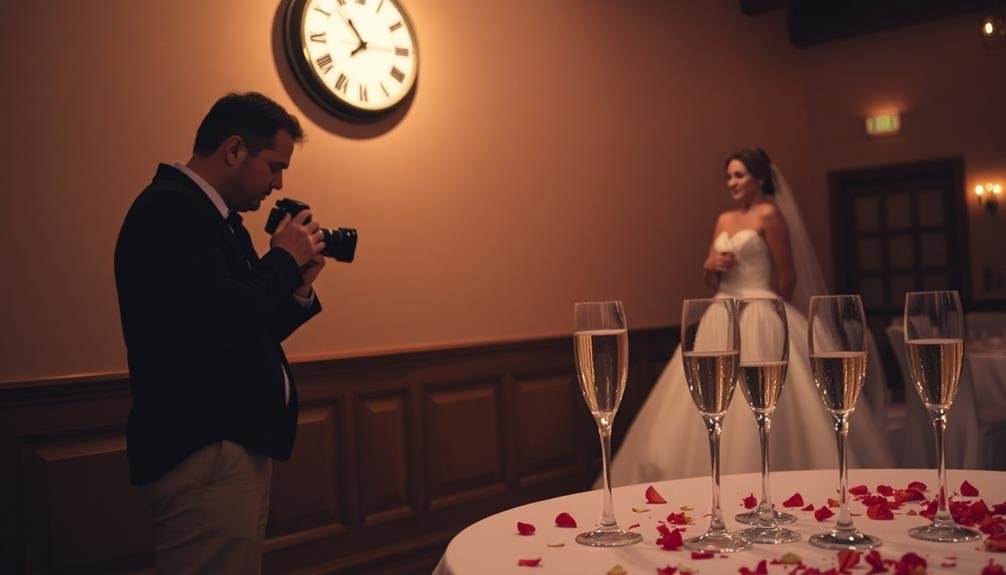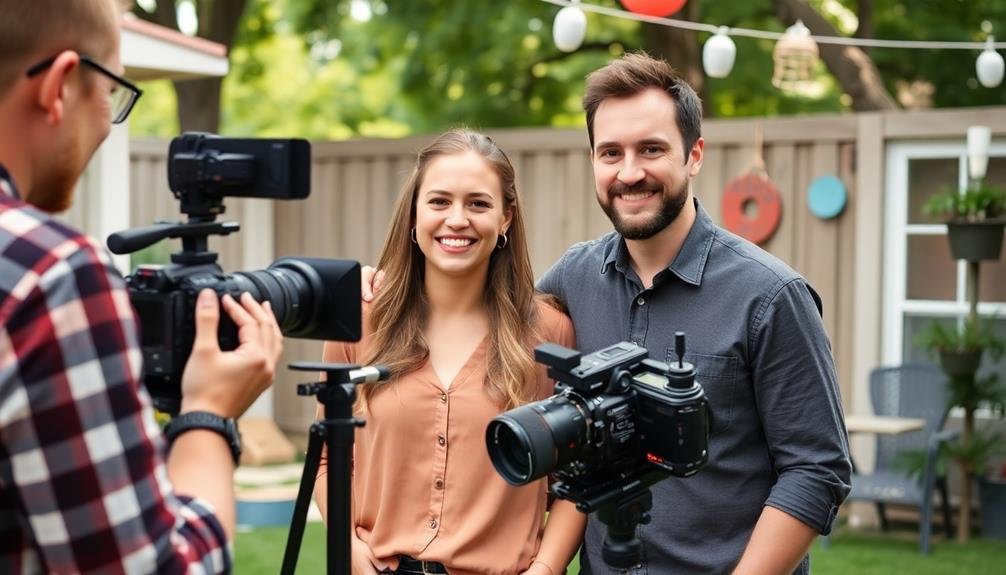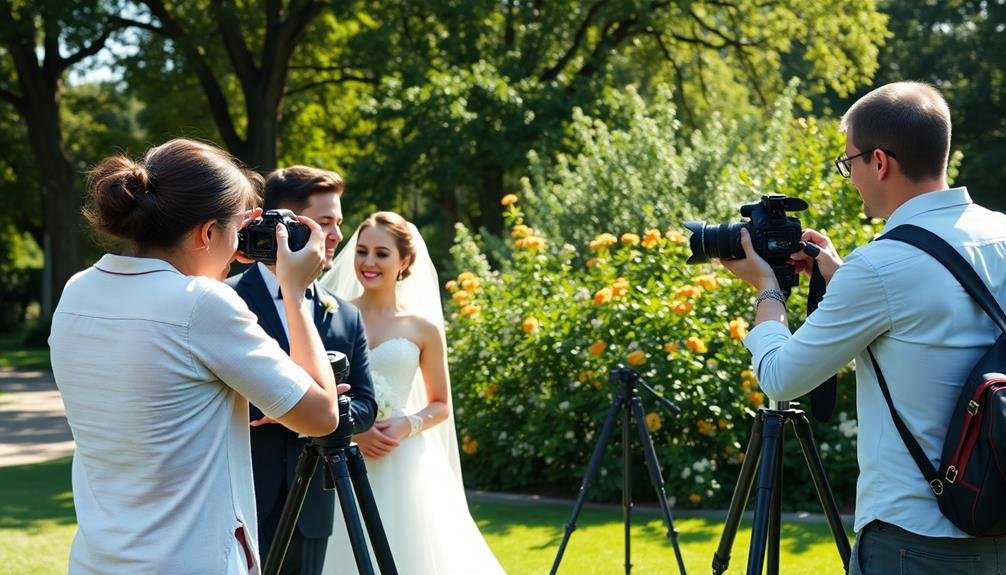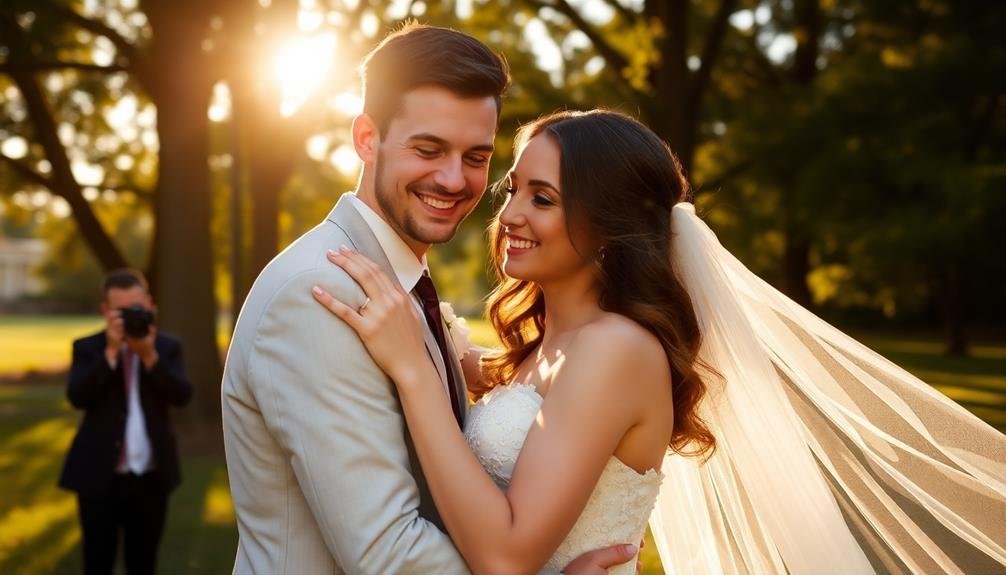To plan a budget-friendly wedding photography and videography session, start by defining your priorities and negotiating customized packages. Research local talent, including photography students, for affordable options. Consider off-peak wedding dates and limit coverage hours to essential moments. Opt for digital-only packages and remove unnecessary extras to cut costs. Leverage friends and family with photography skills, and explore equipment sharing opportunities. Create a DIY photo booth and crowdsource guest photos for added coverage. Utilize online planning tools to stay organized and communicate your vision effectively. With these strategies, you'll capture beautiful memories without breaking the bank.
Key Takeaways
- Define your photography priorities and customize packages to focus on essential shots and services.
- Research local talent, including photography students, for more affordable options.
- Consider off-peak wedding dates and limit coverage hours to reduce costs.
- Opt for digital-only packages and remove unnecessary extras from photography/videography offerings.
- Leverage friends and family skills, and explore equipment sharing opportunities to supplement professional services.
Define Your Photography Priorities

Every couple has unique preferences when it comes to wedding photography. To keep costs down while still capturing your special day, it's essential to define your priorities.
Start by discussing with your partner what aspects of the wedding are most important to preserve in photos and videos. Do you want to focus on the ceremony, reception, or both? Are candid shots more appealing than posed portraits?
Consider which moments you absolutely can't miss, such as the first kiss, exchanging rings, or cutting the cake. Decide if you need full-day coverage or if a shorter timeframe will suffice.
Think about the style of photography you prefer – traditional, photojournalistic, or artistic. Don't forget to contemplate whether you want both photos and videos or if one medium is enough.
Once you've outlined your priorities, you can communicate them clearly to potential photographers and videographers. This will help you find professionals who align with your vision and budget.
Research Local Talent

When it comes to finding budget-friendly wedding photography and videography, your local area might be a goldmine of talent. Start by exploring online platforms like Instagram, Facebook, and local wedding forums to discover up-and-coming photographers and videographers. Don't overlook art schools or photography clubs in your area, as they often have talented students looking to build their portfolios.
Once you've identified potential candidates, review their work carefully. Look for consistency in style, attention to detail, and the ability to capture emotion. Reach out to them for quotes and inquire about package options. Remember, newer professionals may offer competitive rates to establish themselves in the industry.
| Research Methods | Benefits |
|---|---|
| Social Media | Wide reach, current work |
| Art Schools | Fresh talent, lower rates |
| Wedding Forums | Recommendations, reviews |
| Local Directories | Established professionals |
Consider attending local wedding expos or fairs to meet photographers and videographers in person. This gives you the opportunity to see their work firsthand and gauge their personality. It's essential to find someone you're comfortable with, as they'll be capturing intimate moments on your special day. Don't hesitate to ask for references and read reviews from previous clients to guarantee you're making an informed decision.
Consider Off-Peak Wedding Dates

In light of budget constraints, opting for off-peak wedding dates can greatly reduce your photography and videography costs. Typically, off-peak seasons include late fall and winter months, excluding major holidays. Many photographers and videographers offer discounted rates during these periods to attract more business.
Consider scheduling your wedding on a Friday or Sunday instead of the popular Saturday. You'll likely find more availability and lower prices for these days. Weekday weddings can offer even steeper discounts, though they may be less convenient for guests.
Time of day matters too. Early morning or late afternoon ceremonies often cost less than those held during peak hours. Some photographers offer shorter coverage packages for these times, which can greatly cut costs.
Be flexible with your date. If you're open to multiple options, ask your preferred vendors about their least busy dates. They might offer special rates to fill these slots.
Limit Coverage Hours

Another effective strategy to reduce wedding photography and videography costs is to limit your coverage hours. Instead of booking professionals for the entire day, focus on capturing the most important moments.
Start by prioritizing which parts of your wedding day you want documented. Consider having photographers and videographers arrive just before the ceremony and stay until the reception's main events are over.
You can save money by skipping coverage of pre-wedding preparations or the latter part of the reception. Many couples find that 6-8 hours of coverage is sufficient to capture the essence of their special day.
Discuss your timeline with your chosen professionals to guarantee they can cover all essential moments within the limited timeframe.
If you're worried about missing out on certain moments, enlist the help of friends and family to take candid shots during uncovered periods. You can also set up photo booths or disposable cameras for guests to use, adding a fun element to your reception while supplementing your professional coverage.
Opt for Digital-Only Packages

Choosing digital-only packages can considerably reduce your wedding photography and videography costs. By opting for digital files instead of physical prints or albums, you'll save on printing and production expenses. Many photographers offer tiered packages, with digital-only options being the most affordable. You'll receive high-resolution images and video files that you can easily share online or print later at your convenience.
Digital-only packages offer several benefits:
- Flexibility to print or share as you wish
- Lower upfront costs
- Easy storage and backup of memories
- Freedom to create custom photo books or albums later
When selecting a digital-only package, make certain you understand the terms. Ask about the number of edited photos you'll receive, the resolution of images and videos, and any restrictions on usage rights.
Some photographers may offer online galleries for easy sharing with family and friends. You can also inquire about the option to purchase prints or albums later if you change your mind.
Hire Separate Photo and Video

When planning your wedding media coverage, consider hiring separate photographers and videographers.
You'll need to carefully compare costs and benefits, as individual professionals might offer specialized skills at competitive rates.
To make this approach work, you'll have to coordinate schedules effectively, ensuring both teams can capture your special day without conflicts.
Compare Costs and Benefits
Many couples consider hiring separate photographers and videographers for their wedding day.
When comparing costs and benefits, you'll need to weigh several factors. Separate professionals often specialize in their respective fields, potentially offering higher quality results. However, this approach can be more expensive and may lead to coordination challenges on your big day.
To make an informed decision, consider these key points:
- Cost: Compare package prices for individual services vs. combined photo-video packages
- Experience: Assess the portfolios and expertise of separate professionals vs. all-in-one services
- Equipment: Evaluate the quality and variety of gear used by individual specialists
- Coordination: Consider the logistics of managing multiple vendors vs. a single team
Coordinate Schedules Effectively
Three key strategies can help you effectively coordinate schedules when hiring separate photo and video professionals for your wedding.
First, create a detailed timeline of your wedding day, including specific times for each event and photo/video opportunity. Share this timeline with both professionals well in advance, allowing them to plan their coverage accordingly.
Second, arrange a pre-wedding meeting with both the photographer and videographer. This meeting provides an opportunity to discuss their respective shooting styles, equipment needs, and preferred locations.
Encourage them to collaborate on ideas for capturing key moments without interfering with each other's work.
Lastly, designate a point person to manage communication between you and the photo/video team on the wedding day. This could be a wedding planner, a trusted friend, or a family member.
They'll guarantee that both professionals are aware of any last-minute changes or special requests.
Leverage Friends and Family

Assess your friends' and family members' photography and videography skills to assign appropriate roles for capturing your special day.
You might discover hidden talents and equipment that can be shared, reducing the need for professional rentals.
Consider pairing amateur shooters with professionals to create a collaborative team that blends personal touches with polished expertise.
Skill Assessment and Roles
Leveraging your friends and family's skills can greatly reduce wedding photography and videography costs. To make the most of their talents, start by evaluating their abilities and experience. Reflect on their past work, equipment, and comfort level with capturing important events.
Once you've identified potential candidates, assign specific roles based on their strengths.
- Camera operators for ceremony and reception
- Portrait photographers for formal shots
- Candid photo takers for guest interactions
- Video editors for post-production work
Discuss expectations clearly with each person, ensuring they understand their responsibilities and the desired outcome. Provide them with a shot list and timeline to keep everyone on track.
Don't forget to think about backup plans in case someone can't fulfill their role at the last minute.
Equipment Sharing Opportunities
One of the most effective ways to cut costs on wedding photography and videography is by sharing equipment with friends and family.
Begin by reaching out to your social circle to see who owns high-quality cameras, lenses, tripods, or lighting equipment. You'll be surprised how many people have invested in photography gear over the years.
Create an inventory of available equipment and match it with your needs.
Don't hesitate to mix and match brands; most modern cameras and lenses are compatible with various accessories. If you're missing essential items, consider renting them instead of buying.
Organize a equipment sharing schedule to make certain everyone knows when and where to drop off or pick up gear.
Be sure to discuss insurance and liability in case of damage.
Offer to compensate equipment owners with prints or digital copies of your wedding photos as a gesture of appreciation.
Coordinating Amateur-Professional Collaboration
Teaming up skilled amateurs with professional photographers can greatly cut down on wedding costs while still ensuring high-quality results. Consider enlisting the help of friends or family members who've experience in photography or videography. They can work alongside a professional, capturing candid moments and additional angles that might otherwise be missed.
To coordinate this collaboration effectively, start by evaluating the skills of your amateur helpers. Assign them specific roles based on their strengths, such as candid shots, guest photos, or detail captures. Have a clear communication plan in place, ensuring everyone knows their responsibilities and how to work together seamlessly.
Here are some key benefits of amateur-professional collaboration:
- Cost savings on additional professional photographers
- More extensive coverage of your special day
- Unique perspectives from people who know you well
- Opportunity for aspiring photographers to gain experience
Remember to discuss this arrangement with your hired professional beforehand. They can provide guidance on equipment, shooting techniques, and coordination strategies.
This collaboration can result in a diverse collection of images and footage that capture your wedding day from multiple angles and perspectives, all while keeping your budget in check.
Explore Photography Students

Have you considered tapping into the talent pool of aspiring photographers? Photography students can offer a budget-friendly alternative for your wedding while gaining valuable experience.
Start by contacting local art schools, colleges, or universities with photography programs. Many institutions have job boards or career centers that can connect you with talented students.
When exploring this option, review student portfolios to confirm their style aligns with your vision. Look for those who've worked on weddings or similar events before.
Discuss your expectations, timeline, and specific shots you want captured. Be clear about the level of editing and post-production you're expecting.
Remember, while students may offer lower rates, they're still developing their skills. Consider hiring a more experienced photographer for key moments and using students for candid shots or secondary coverage. This approach can provide a mix of professional results and budget-friendly options.
Offer to provide a testimonial or allow the student to use select images in their portfolio. This can be a win-win situation, giving you affordable photography while helping a budding professional build their career.
Negotiate Package Customization

When negotiating with photographers and videographers, you'll want to tailor their packages to your specific needs.
Don't hesitate to ask about removing unnecessary extras that don't align with your vision or budget.
Tailor to Your Needs
Most wedding photography and videography packages come pre-designed, but they're not set in stone. You can tailor these packages to fit your specific needs and budget. Start by identifying your must-have shots and services, then communicate these priorities to your photographer or videographer. They'll often be willing to adjust their offerings to accommodate your requests.
Consider the following when customizing your package:
- Coverage duration: Determine how many hours you actually need
- Number of photographers or videographers
- Specific shot types or locations you want captured
- Deliverables: prints, albums, or digital files
Don't hesitate to ask for substitutions. If you're not interested in engagement photos, see if you can swap them for additional coverage on your wedding day. Similarly, if you don't need printed albums, inquire about exchanging them for more digital images or video footage.
Remove Unnecessary Extras
Many wedding photography and videography packages include extras that you mightn't need or want. To keep costs down, carefully review the package offerings and identify items you can do without. Common add-ons that may not be essential include engagement photo sessions, photo albums, or extensive video editing.
Don't hesitate to ask your photographer or videographer about customizing their packages. Most professionals are willing to remove certain elements and adjust the price accordingly. For instance, you might opt for digital-only delivery instead of printed photos, or choose a shorter coverage time if you're having a more intimate celebration.
Consider prioritizing what's most important to you. If you're more interested in candid shots, you might forego formal posed portraits.
Similarly, if you're not planning to watch your wedding video frequently, a simpler edit might suffice. By focusing on your core needs, you can greatly reduce costs without sacrificing the quality of your memories.
Bundle Core Services
Building on the idea of customizing your photography and videography services, bundling core services can offer significant savings.
Many photographers and videographers offer package deals that combine essential elements of both services. By opting for a bundled package, you'll often pay less than if you were to book each service separately.
When negotiating your package, focus on the core services you need most. These typically include:
- Full-day coverage of your ceremony and reception
- A set number of edited photos
- A highlight video of your wedding day
- Online gallery access for sharing with family and friends
Don't be afraid to ask for customization options within the bundle. You might be able to swap out less important features for ones you value more.
For example, you could trade a wedding album for an extra hour of coverage or additional edited photos.
Utilize Online Planning Tools

Efficiency is key when planning a budget-friendly wedding photography and videography experience. To streamline your process and save money, take advantage of online planning tools. These digital resources can help you organize your ideas, communicate with vendors, and stay on track with your budget.
Start by creating a shared online document or spreadsheet to outline your photography and videography needs. Include shot lists, timelines, and must-have moments. Use free project management tools like Trello or Asana to assign tasks, set deadlines, and collaborate with your partner and vendors.
Explore wedding-specific platforms such as WeddingWire or The Knot, which offer free planning tools, vendor directories, and budget calculators. These sites can help you find affordable photographers and videographers in your area, compare prices, and read reviews from other couples.
Don't forget about social media platforms like Pinterest and Instagram. Create boards or collections to gather inspiration for your wedding photos and videos. Share these with your chosen professionals to guarantee they understand your vision and can work within your budget constraints.
DIY Photo Booth Ideas

A photo booth adds a fun, interactive element to your wedding without breaking the bank. You can create a DIY photo booth that's both cost-effective and personalized to your wedding theme.
Start by selecting a suitable backdrop, which could be a decorated wall, a large frame, or even a scenic outdoor location. Next, gather props that reflect your personalities and wedding style, such as funny hats, signs, or themed accessories.
To capture the photos, you have several options. You can set up a camera or smartphone on a tripod with a remote shutter or timer. Alternatively, designate a friend or family member to man the booth and take photos. For printing, consider renting a portable printer or using a digital sharing option where guests can instantly access their photos online.
Here are some creative DIY photo booth ideas to inspire you:
- Create a flower wall backdrop using artificial blooms
- Design a chalkboard backdrop for guests to write messages
- Hang a fabric curtain with string lights for a glamorous look
- Set up a vintage window frame or door as a unique photo frame
Remember to provide clear instructions for your guests and guarantee there's adequate lighting for great photos.
Crowdsource Guest Photos

Crowdsourcing guest photos is an innovative way to capture your wedding from multiple perspectives while saving on professional photography costs. You can encourage guests to take photos throughout the event and share them with you using various methods.
Create a unique wedding hashtag and ask guests to use it when posting photos on social media platforms like Instagram or Twitter. This makes it easy for you to collect and view all the shared images in one place. Alternatively, set up a dedicated photo-sharing app or website where guests can upload their pictures directly.
Consider providing disposable cameras on each table or creating a photo station with props and backdrops. This can inspire guests to take more photos and add a fun element to the reception.
You can also designate a few friends or family members as "unofficial photographers" to guarantee key moments are captured.
After the wedding, curate the best guest photos to create a unique album that showcases different perspectives of your special day. You'll end up with a diverse collection of candid shots that complement any professional photos you may have.
Book Early for Discounts

While guest photos can provide unique perspectives, you may still want professional coverage for your wedding. Booking your photographer and videographer early can often lead to significant savings. Many professionals offer early bird discounts to secure bookings in advance, which can help you stretch your budget further.
Start your search for vendors as soon as you've set your wedding date. This gives you ample time to compare prices, portfolios, and packages. Don't hesitate to negotiate with potential photographers and videographers. They may be willing to offer additional discounts or perks for early bookings, especially during off-peak seasons or weekdays.
When booking early, consider these benefits:
- Lower rates due to early bird discounts
- More time to customize your package
- Ability to secure your preferred date before it's taken
- Opportunity to build a relationship with your vendors
Remember to read contracts carefully and understand what's included in your package.
Early booking also allows you to spread out payments over a longer period, making it easier to manage your wedding budget. By securing your photography and videography services well in advance, you'll have one less thing to worry about as your big day approaches.
Maximize Natural Lighting Opportunities

Natural light is a photographer's best friend and a budget-friendly tool for stunning wedding images. To maximize natural lighting opportunities, schedule your ceremony and key photo sessions during the golden hour, typically an hour after sunrise or before sunset. This soft, warm light creates a romantic atmosphere and flattering shadows, reducing the need for expensive artificial lighting equipment.
Choose venues with ample windows or outdoor spaces that allow natural light to flood in. Consider gardens, beaches, or rustic barns for a naturally lit backdrop. If you're having an indoor ceremony, position yourselves near large windows to take advantage of the available light.
For outdoor shoots, seek out shaded areas to avoid harsh shadows and squinting. Communicate with your photographer about your desire to use natural light. They can scout locations in advance and plan shots accordingly.
Don't forget to have a backup plan for overcast days or indoor evening receptions. Ask your photographer to bring minimal lighting equipment for these situations, which can help keep costs down while ensuring quality photos regardless of conditions.
Frequently Asked Questions
How Do I Handle Rain or Bad Weather on My Wedding Day?
Don't panic! Have a backup indoor location ready. Embrace the rain with clear umbrellas for unique photos. Coordinate with your photographer to capture moody, romantic shots. Remember, rain on your wedding day is considered good luck in many cultures.
What's the Ideal Photographer-To-Guest Ratio for a Wedding?
You'll typically want one photographer for every 50 guests. However, for smaller weddings, one photographer can often handle up to 100 guests. Consider your venue size, timeline, and desired coverage when deciding on the ideal ratio.
Should We Do a "First Look" Photo Session Before the Ceremony?
You should consider a "first look" session before the ceremony. It's a great way to capture intimate moments, ease pre-wedding jitters, and allow more time for photos. However, it's ultimately a personal choice based on your preferences.
How Can I Incorporate Drone Photography Into My Wedding Without Breaking the Budget?
You can incorporate budget-friendly drone photography by hiring a photographer with drone skills, renting a drone, or asking a skilled friend to help. Limit drone shots to key moments, like the venue overview or grand exit.
What's the Best Way to Coordinate Multiple Photographers During the Event?
To coordinate multiple photographers, you'll want to assign specific roles and locations. Create a detailed shot list, set up a group chat for quick communication, and schedule a pre-event meeting to discuss logistics and timing. Don't forget backup plans!
In Summary
You've now got a toolkit for budget-friendly wedding photography and videography. Remember, it's all about balance – prioritize what matters most and get creative with the rest. Don't be afraid to negotiate or think outside the box. With these tips, you'll capture beautiful memories without breaking the bank. Your wedding day is unique, and your approach to preserving it can be too. Embrace the process and enjoy the results!

I’m Sarah, the creator and writer behind this site. I’m a wife and a mother of two wonderful kids who keep me on my toes and inspire me daily. My passion lies in creating and organizing memorable events and group activities, where people can come together and make lasting memories.





Leave a Reply